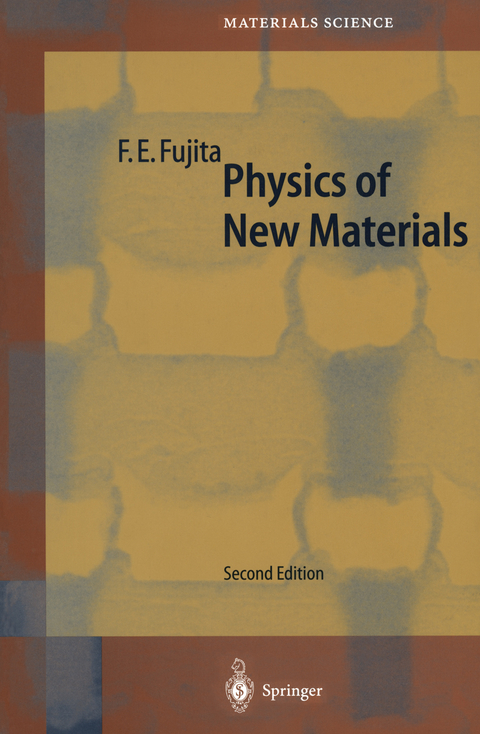
Physics of New Materials
Springer Berlin (Verlag)
978-3-642-46864-3 (ISBN)
1 Introductory Survey.- 1.1 New Materials and Necessity of Physics in their Development.- 1.2 Examples of Physics of New Materials.- 1.3 Brief Introduction of the Contents.- References.- 2 Electronic Structure and Properties of Transition Metal Systems.- 2.1 Background.- 2.2 Basic Concepts of Electronic Structure Calculation of Transition Metal Systems.- 2.3 Bulk and Defect Electronic Structure of Ferromagnetic Transition Metal Systems.- 2.4 Structural Problems.- 2.5 Limitation of the One Electron Theory.- 2.6 Future Development.- References.- 3 Structure Characterization of Solid-State Amorphized Materials by X-Ray and Neutron Diffraction.- 3.1 New Generation Scattering Experiments.- 3.2 Mechanical Alloying and Mechanical Disordering.- 3.3 Medium-Range Structure of Metallic Amorphous Alloys.- 3.4 Conversion of Organic Polymers to Amorphous Ceramics.- 3.5 Hydrogen-Induced Amorphization.- References.- 4 Nanophase Materials: Synthesis, Structure, and Properties.- 4.1 Background.- 4.2 Synthesis and Processing.- 4.3 Structure and Stability.- 4.4 Properties.- 4.5 Future Directions.- References.- 5 Intercalation Compounds of Transition-Metal Dichalcogenides.- 5.1 Background.- 5.2 Electronic Band Structures of 3d Transition-Metal Intercalated Compounds of 1T-Type TiS2.- 5.3 Bonding Nature in MxTiS2 (M: 3d Transition-Metal).- 5.4 Electronic Band Structures of AgxTiS2.- 5.5 2H-Type TX2 (T = Nb, Ta; X = S, Se) Intercalated with Transition-Metals.- 5.6 Discussion.- References.- 6 Structural Phase Transformation.- 6.1 General View.- 6.2 A Phenomenological Theory and a Statistical View of Phase Transition.- 6.3 Martensitic Transformation of Metals and Alloys.- 6.4 Shape Memory Effect and Premartensitic Phenomena.- 6.5 Martensite and Other Problems in Ceramics.- 6.6Conclusions.- References.- 7 The Place of Atomic Order in the Physics of Solids and in Metallurgy.- 7.1 Historical Development.- 7.2 Antiphase Domains.- 7.3 Theory of Ordering.- 7.4 Special Experimental Methods.- 7.5 Ordering Kinetics and Disorder Trapping.- 7.6 Computer Simulation of Ordering and Disordering and Related Features.- 7.7 Ordering and Disordering at Free Surfaces, Interfaces and at Antiphase Domain Boundaries.- 7.8 Magnetic and Atomic Order.- 7.9 Ordering in Semiconductors and Other Non-Metals.- 7.10 Order and Mechanical Properties.- 7.11 Conclusion.- 7.12 Addendum.- References.- 8 Usefulness of Electron Microscopy.- 8.1 Background.- 8.2 Principles of Image Formation.- 8.3 High-Resolution Electron Microscopy.- 8.4 Indispensable Applications of HVEMy.- 8.5 New Research Fields by HVEMy "Micro-Laboratory".- 8.6 Conclusions.- References.- 9 Mössbauer Spectroscopy in Materials Science.- 9.1 Historical Remarks.- 9.2 Principles.- 9.3 Hyperfine Interaction.- 9.4 Polarization and Thickness Effects.- 9.5 Phase Analysis.- 9.6 Cu-Fe System.- 9.7 Precision Phase Analysis.- 9.8 Amorphous Metals, General.- 9.9 Amorphous Metals, Experimental.- 9.10 Nanocrystalline Materials.- 9.11 Crystallization.- 9.12 Simultaneous Triple-Radiation Mössbauer Spectroscopy (STRMS).- 9.13 Quo Vadis?.- References.- 10 Further Progress.- 10.1 Eelectronic Structure and Magnetism of Transition Metal Systems.- 10.2 Structure Characterization of Solid-State Amorphized Materials by X-Ray and Neutron Diffraction.- 10.3 Recent Progress in Nanophase Materials.- 10.4 Further Progress in the Theory of Intercalation Compounds.- 10.5 Various New-type Carbon Materials.- 10.6 New Findings in Ordered Structures.- 10.7 Recent Developments in High-Resolution and High-Voltage Electron Microscopy.- 10.8New Directions in Mössbauer Spectroscopy.
| Erscheint lt. Verlag | 17.3.2012 |
|---|---|
| Reihe/Serie | Springer Series in Materials Science |
| Co-Autor | R.W. Cahn, F.E. Fujita, H. Fujita, U. Gonser, J. Kanamori, K. Motizuki, R.W. Siegel, N. Sumida, K. Suzuki, N. Suzuki |
| Zusatzinfo | XII, 318 p. |
| Verlagsort | Berlin |
| Sprache | englisch |
| Maße | 155 x 235 mm |
| Gewicht | 510 g |
| Themenwelt | Naturwissenschaften ► Physik / Astronomie ► Atom- / Kern- / Molekularphysik |
| Naturwissenschaften ► Physik / Astronomie ► Festkörperphysik | |
| Technik ► Maschinenbau | |
| Schlagworte | Advanced materials • Ceramics • Chemistry • Development • electron microscopy • Festkörperphysik und Festkörperchemie • Material Science • Materials Science • Metall • Microscopy • Mössbauer spectroscopy • Physics • Polymers • Science • semiconductors • solid-state physics and chemistryC • spectroscopy • X-Ray |
| ISBN-10 | 3-642-46864-0 / 3642468640 |
| ISBN-13 | 978-3-642-46864-3 / 9783642468643 |
| Zustand | Neuware |
| Haben Sie eine Frage zum Produkt? |
aus dem Bereich


